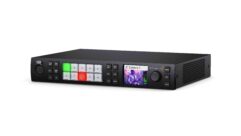
Picture This: Digital Quality
Jan 1, 2007 12:01 PM,
By Jeff Sauer
THX projector certification puts the seal of approval on high-quality display.

The Runco VX-6000d is among the first projectors certified by THX to be shipped to consumers.
Most moviegoers would probably recognize the name “THX.” Even my young children know it — albeit with a little contextual help — from their Toy Story, Monsters Inc., and The Incredibles DVDs. “It’s the cow sound at the beginning of movies,” they tell me, referring to one of the THX animations popular on DVD releases, which features a chorus of cows mooing the THX deep-note chord.
Moviegoers have been hearing that big sound before the start of feature films in theaters for more than 20 years — and lately in their home theaters. (You can view five THX “Deep Note” trailers at www.thx.com/trailers.) It’s a sound that implies the audio will be full and rich. And although the average person may not realize it, the sound also indicates that the movie was produced in accordance with audio industry best practices established by THX engineers.
THX is not a standards organization, per se, such as the International Organization for Standardization (ISO) or the Society of Motion Picture and Television Engineers (SMPTE). Rather, THX is a for-profit company that has carved out a niche in developing high-quality standard operating procedures and practices for audio production and audiovisual equipment. That big-sound trailer is the most recognizable aspect of THX, but AV professionals will also recognize THX from its certification of high-quality consumer audio gear from amplifiers to home theater cabling. To consumers, the THX logo means they are buying products that have been tested by THX engineers and determined to have met a long list of minimum performance standards for producing a great audiovisual home theater experience.
VIDEO CERTIFICATION
As the industry and technology have evolved, THX has refined its standards and added new ones. For example, multimedia certification is designed for desktop computer audio performance. As audio technology has improved over time, THX has established “Ultra” and “Select” tiers for certification of equipment that targets different room sizes, different uses, and different audiences.
The most recent addition to THX’s portfolio is display certification. At CEDIA 2006, THX joined with Runco to announce a new program for high-quality home theater projectors. In early December, Runco announced it was shipping the first THX-certified projectors, including the VX-22d, VX-44d, VX-55d, VX-2000d, and VX-6000d. Like qualified products for other THX certification programs, these projectors have met a set of performance standards and have been determined by THX to be of a high enough quality to carry the THX certification logo.
Because the THX brand is so well recognized, the THX certification logo itself may be enough to lead many consumers toward a particular projector. At least that’s what Runco is counting on — as are most of the manufacturers that go through the testing process to gain THX certification. The THX testing and certification process is part of a licensing program that ultimately adds to the manufacturer’s cost of goods sold. How much the licensing fee is depends on the type of product, sales volumes, and other factors that aren’t readily quotable. Suffice it to say that manufacturers need to feel it’s enough of an asset to warrant the additional cost.
The only way that happens is if THX maintains high quality standards — and that often means requiring potential licensees to make changes to the original design of their equipment, according to Robert Hewitt, VP of sales at THX. As long as THX can guarantee the consumer a top-quality product, the company essentially has the authority to help prevent manufacturers from cutting corners.
QUALITY TESTING
As Sound & Video Contractor readers may know, testing displays often amounts to a fairly straightforward series of tests and procedures. In many ways, THX tests the same things using the same industry-standard procedures. For projectors and other display products, the tests break down into two groups: one that deals with the image engine and one that deals with device’s signal processing.
Image engine tests include luminance (often erroneously termed “brightness”), sequential contrast, checkerboard contrast, primary and secondary color accuracy, gamma tracking, grayscales, resolution, luminance uniformity (including uniformity tests on white, black, and gray screens), viewing angle, and convergence.
Signal processing tests include de-interlacing, mostly using 1080i sources; motion compensation; cadence detection and correction; jaggies; contouring; sharpness; noise reduction; overscanning; image break-up; and audible fan noise (except for products designed to be mounted in a cabinet).
NO-CURVE GRADING
In a real way, at least to AV pros who have been around a while, there is nothing terribly mysterious about any of those testing procedures. Sound & Video Contractor uses them, as do other product testers and manufacturers doing their own internal testing. But THX certification places specific limits on what is acceptable and what is not. And unlike editorial testing that typically takes factors such as price, performance, and target market into account, THX is strictly concerned with performance — specifically, performance at a high level.
THX isn’t able to speak directly to what passing and failing actually mean — and that partly has to do with the fact that some tests are ultimately subjective and determined by the eyes of the tester. Image quality-related tests such as noise reduction, sharpness, motion compensation, and cadence detection are relevant only when performed consistently, using a specific group methodology. Of course, that’s where the THX certification gains its mettle.
But it’s also awkward for THX to talk about specific measurements, because simply reciting numbers such as a sequential contrast of 2000:1 or convergence errors of less than .5 pixels tells only part of the story. It would be easy enough for display marketers to tout “passes or exceeds THX certification requirements” for specific tests, and consumers might well be misled. What ultimately qualifies for THX certification is the entire product, not just individual specifications or capabilities. And in addition to high quality, THX also requires the inclusion of one or more THX-preferred viewing modes, or presets, to help less experienced consumers get the most out of their THX-certified equipment.
Is that type of certification an asset to the consumer, particularly if a manufacturer is ultimately passing on the licensing costs? And aren’t there already so many logos on products that one more will just confuse consumers or escape their notice?
The answer to both of those questions rests entirely on how well the brands are established and protected. Reputations can change quickly, but THX has been holding onto its reputation for more than 20 years, and has managed to keep it focused on quality. Now, that reputation extends to display image quality.
Jeff Sauer
is a video producer and an industry consultant based in Massachussetts.










